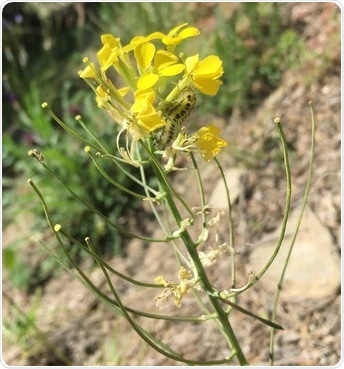A new study shows that two chemicals used by wallflowers and their family to keep predators at bay have evolved to complement each other.
One of them targets common herbivores and the other targets unique herbivores that have turned resistant to the usual defense.

A Rhaetian wallflower (Erysimum rhaeticum) under attack by a caterpillar Image Credit: Tobias Züst.
Plants have been involved in an ongoing arms race with the creatures that feed on them. They develop defenses to inhibit plant-eaters, while their herbivores develop counter-defenses.
In a recent study published in eLife, the details of the evolutionary chemical arms race in the wallflower genus Erysimum—a class of flowering plants in the mustard family Brassicaceae—have been described.
In all Brassicaceae plants, the first line of defense are chemicals known as glucosinolates, which get activated when predatory creatures taste the plants.
Currently, wallflowers have developed a second line of defense by synthesizing chemicals known as cardenolides to inhibit the plant-eating creatures that developed defenses to glucosinolates.
Studying how these two defenses evolved in this large genus can help scientists understand the trade-offs that the plants face as they try to defend themselves against multiple enemies.”
Tobias Züst, PhD, Study Lead Author and Research Associate, Institute of Plant Sciences, University of Bern
Züst and his colleagues sequenced the genome of the wormseed wallflower—short-lived wild mustard—to perform this study. They sketched a detailed family tree for this plant and 47 other species of wallflower. Then, they compared it with the diversity and abundance of cardenolides and glucosinolates across these species.
The researchers deciphered that the two defenses differed independently of each other and that closely associated, geographically co-habituating species shared analogous cardenolide traits, but not glucosinolate traits. This is possibly due to the effect of separate selective pressures on each defense.
Even though most species co-expressed two different types of potentially costly chemical defenses, there was no evidence of a trade-off between glucosinolates and cardenolides. Instead, these two types of chemicals appear to complement each other and do not serve redundant functions.”
Tobias Züst, PhD, Study Lead Author and Research Associate, Institute of Plant Sciences, University of Bern
Züst added that the evolution of cardenolides is in accordance with an exponential increase in the number of wallflower species, which indicated that the second line of complementary defense could have enabled the plants to succeed and diversify into new habitats.
Further analysis of the wormseed wallflower genome will be needed to help scientists identify glucosinolate and cardenolide-producing genes in this species, as well as aid our understanding of the function of these chemicals in the evolution of Brassicaceae defenses.”
Georg Jander, Study Senior Author and Professor, Boyce Thompson Institute
Source:
Journal reference:
Züst, T., et al. (2020) Independent evolution of ancestral and novel defenses in a genus of toxic plants (Erysimum, Brassicaceae). eLife. doi.org/10.7554/eLife.51712.